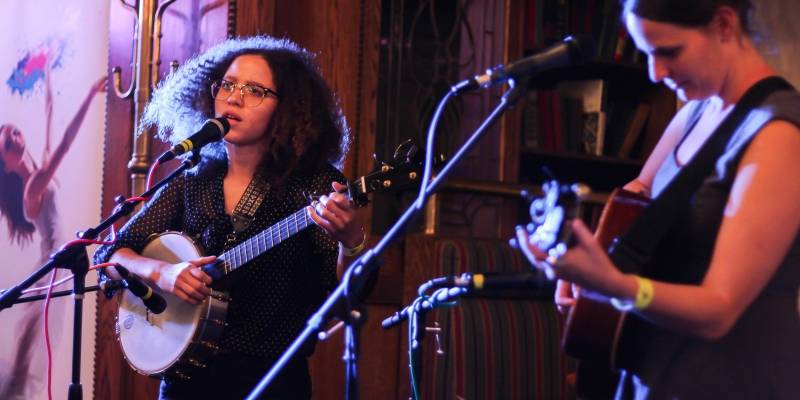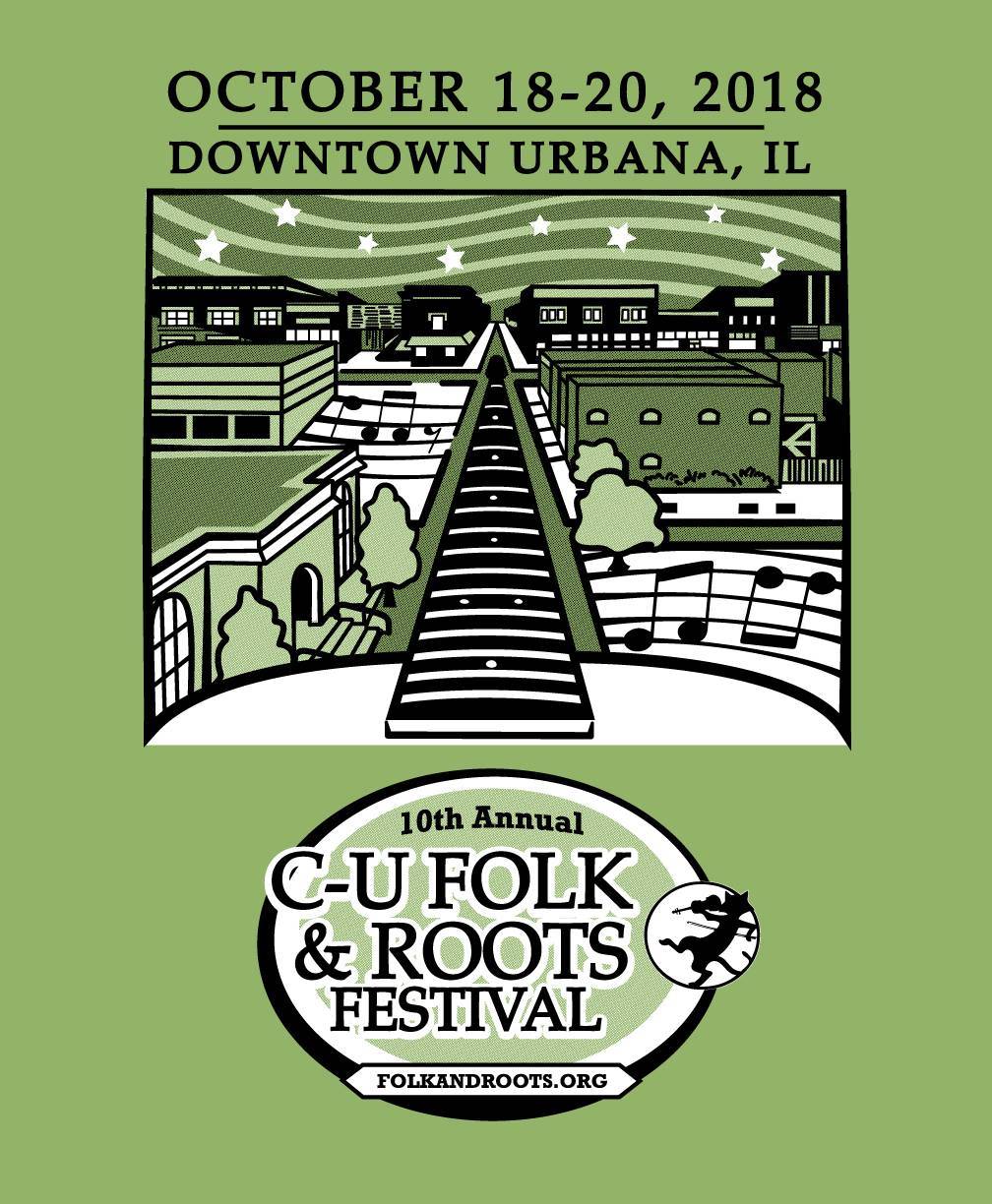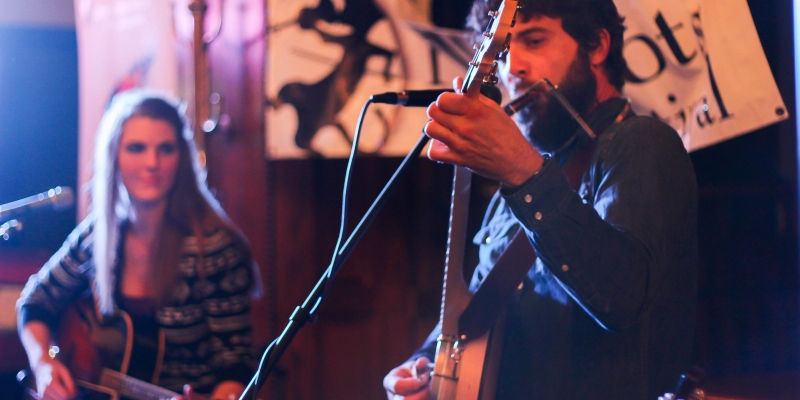The recent, suddenly cool weather and the flourishes of bright yellow, orange and red now adorning many local trees are two signs that fall is upon us. For many here in Champaign-Urbana, this means corn mazes, apple and pumpkin picking at Curtis Orchard and droves of costumed kids tricking and treating.
However, fall in Champaign-Urbana also means it’s time for the C-U Folk and Roots Festival to transform downtown Urbana into a music lover’s paradise. Now in its tenth year, the festival strives to bring people from a wide variety of backgrounds together through music and creative expression. From concerts featuring a wide variety of different musical styles and grammy nominated performers like country and bluegrass musician Robbie Fulks to jam sessions, singalongs and even a chance to examine the history of Champaign County, the festival unites musicians and music lovers here in Champaign-Urbana and showcases some of the area’s musical talent. And one glance at this year’s schedule is enough to declare that there is truly something for everyone regardless of age or musical preference.
I had the chance to sit down festival organizers Rob Krumm and Frances Harris
and enjoy a freewheeling discussion about this year’s festival.
Smile Politely: How did the Champaign-Urbana Folk and Roots Festival (CUFRF) get started and how has it evolved over the years.
Rob Krumm: A group of people were brought together in 2008 by a local fiddle player whose name is Brenda Koenig. Pretty much, this was Brenda’s idea to have a festival here in Champaign-Urbana and part of it was to put a spotlight on the local music scene because we do have a rich music scene here. And so Brenda put some feelers out and got a whole bunch of musicians who were living here at the time and we had some initial discussions about running a festival and so that came together the next year. Really, I’d say, Brenda, to her credit, she was the guiding light of the festival for seven, eight years.
Now, the festival is planned by the steering committee which is a group of volunteers that meets monthly to plan the festival. The only month we don’t meet is December but early in the year, in January, we start meeting and planning.
We made the decision years ago to have the festival in downtown Urbana. We like the feel of downtown Urbana. There are a lot of smaller venues like the Rose Bowl, the Iron Post, the Urbana Free Library and the Community Center for the Arts. This year, we’re using the Urbana First United Methodist Church. Their sanctuary is really nice. It’s beautiful in there, the stained glasses windows are just unreal. That’s probably the biggest venue of the festival this year. We made an effort to put some gospel music in the church because that fits. It won’t be all gospel music but we’re definitely featuring some.
SP: It’s the perfect place for it.
Krumm: Yeah. One performer we have is Nikki Brown. She plays lap steel guitar. There’s a sacred steel tradition. Robert Randolph kind of came out of that tradition. So, Nikki, she’s known as the “Jimi Hendrix of Sacred Steel” and her band is called The Sisters of Thunder and it’s a family band with her sisters. They’re playing at the church and if they don’t blow the roof off the church, it’ll be OK [laughs]. But my guess is that it’s gonna be pretty rockin’.
SP: What are the goals of the festival?
Harris: I think we always try to have a good share of local and regional performers as well as getting some national acts. And also, we try to get some of these folks right before they’re really big [laughs] and so some of the people we’ve had, we can’t afford to bring them back now [laughs]. There’s a lot of hidden gems.
Krumm: I think that’s a good way of describing the festival, it’s a hidden gem of a festival. If you look at the schedule, you might say, “I’ve never heard of this person” and I’d tell you, “just go see them anyway”. And thanks to our booking team, over the years, we’ve found a lot of people before they really popped up on the national scene. And some of them have been good enough to come back and perform again. Early on, we only hired maybe one or two bands from outside the area. It was Urbana, Champaign and regional bands. And over the years, we’ve started to hire more national and regional bands.

SP: One of the stated missions for the festival is “to promote a feeling of community”. How do you go about achieving this goal? Why is it important?
Krumm: Well, we want to make this a community event, so that everybody can participate if they want to. It’s important because we’re all musicians and we want everybody to be involved.
Harris: It’s a really healing experience. I don’t want to get all mushy but I would say that there are no political lines. It’s a shared space. Everyone can sing, so we sing. It’s very inclusive. And we’re also diverse in the offerings and diverse in who we attract.
Krumm: Yeah, people come and play here and they say, “everyone is so nice here” [laughs]. And they enjoy it, they really do. People like to hang out and participate in the jam sessions.
Harris: …and have their picture taken in front of the Rose Bowl [laughs]...
Krumm: It’s a pretty laid back, intimate feel. Small rooms, kind of “listening room” quality experiences, you know. If there’s somebody on the schedule that you know, maybe giving a guitar lesson, and you want to hang out afterwards because you’re a fan, that happens because everyone is so accessible.
SP: Looking at the schedule, it seems like there are a lot of musical acts but it also seems like there’s a focus on dancing and workshops and jam sessions. What are some of the other participatory experiences at the festival?
Krumm: Usually, we do this thing called the “Musical Mayhem Parade” that’s for kids of all ages [laughs].. There’s instrument building workshops. There’s a performer, Miss Hanna Rae, who has puppets as part of her performance. That’s for kids. She’s great! She was here last year and we’re happy she’s here again.
Harris: Ukulele. You can learn to play the ukulele. And the harmonica. There are workshops for both of them. There are singalongs, too. There’s a sea chantey sing-along. That’s one of the things that really makes this different from other festivals, the participation.
SP: Is the festival family friendly?
Krumm: Oh, yea. Yeah. The program on Saturday, all day, pretty much from the start to 5 p.m., is all free. One of the missions of the festival that Brenda was so insistent about is making sure its accessible to everybody. Everything is free for kids 12 and under. They can get in anywhere except for The Rose Bowl which is a 21 and over venue anyway [laughs].
SP: Going back to the idea of diversity, that’s another mission statement goal. Looking at the schedule, there’s a diversity in the acts and activities offered. How do you guys go about ensuring diversity as a key feature of the festival?
Krumm: We make an effort to try and diversify the line up. Not just musical styles. We have this Son Monarcas band out of Chicago. They’ve never played in Champaign-Urbana before. Them playing the festival is an opportunity to branch out and play in a new town and it helps the festival try to reach out to the local Mexican-American community to make connections because we do want everybody to feel welcome. That’s one of the reasons why we try to diversify the line-up.
One of the reasons we threw “roots” in the name of the festival is because roots is a more recent term for a lot of genres of folk music that a lot people don’t think about being part of the folk music landscape. In the past, when things were a little more isolated, there were a lot of different blues varieties in the South, like Piedmont blues, Delta blues, North Mississippi Blues, Hill Country Blues. Down in Louisiana, there’s Cajun and Zydeco groups. In New York City, there’s Klezmer bands. Those are some of the genres of folk music that are American folk music that people maybe don’t think about.
Harris: The emphasis is on Americana and things that have become Americana. We’re not the Lotus Festival, we’re not doing world music. But, look at klezmer music. Klezmer has deep American roots now. If you look at the full schedule on the website, you’ll see this huge diversity of sounds.
SP: Are there any particular highlights of this year’s festival? Anything you’re really looking forward to?
Harris: Don’t miss [Jerron] “Blind Boy” Paxton.
Krumm: Oh, yeah. He’s really good. This will be the third time he’s played the festival and he’s a solo performer and he’s a younger man but he kind of channels an older blues spirit. He plays guitar, fiddle, banjo, he sings. He’s a great piano player. He plays blues but he’ll throw in some ragtime piano. He’s also got some particularly, I would say downright bawdy songs that are good for some later night crowds [laughs].
SP: Final question: why should people come to the festival? As they walk out at the end of a performance/workshop/dance session, how might they expect to feel?
Krumm: There’s a bubbling music scene in town. There’s a lot of “under the radar” acts that might not have a bunch of hits and sometimes people are a little unwilling to go out and see somebody new. But I think you can go out and see good music every night of the week in Champaign-Urbana. Our focus on the local music is one of the big goals of the festival. We want to celebrate the music scene here. It’s vibrant.
People should come to participate. And if they don’t come to participate, they should just get to downtown Urbana and try to check out different events. Take a chance on seeing some of these artists that maybe people don’t know. Everything is very accessible. There’s a lot of very impressive musicians on the line-up this year. And yeah, I hope people come. I think they’ll find it a positive experience. And I hope they’ll tell their friends to come next year.

The C-U Folk and Roots Festival starts this Thursday, October 18th and continues on Friday, October 19th and Saturday, October 20th. The full schedule of events can be found here. Complete information about venue locations and admission prices can be found here. Information about how to volunteer for future CUFR festivals can be found here.
Photos by Daniel Shoemaker








